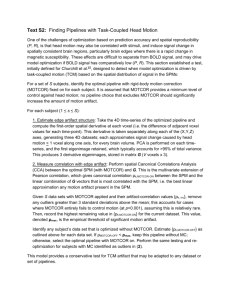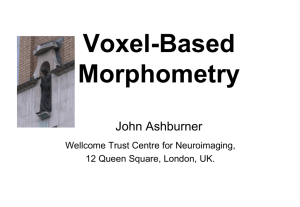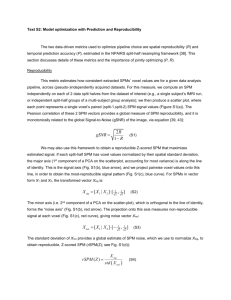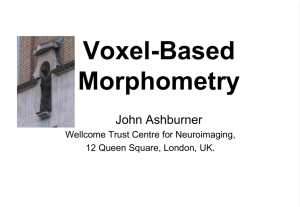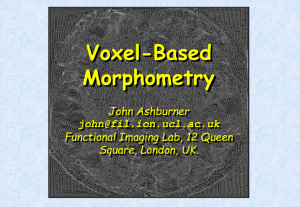Voxel-based morphometry
advertisement
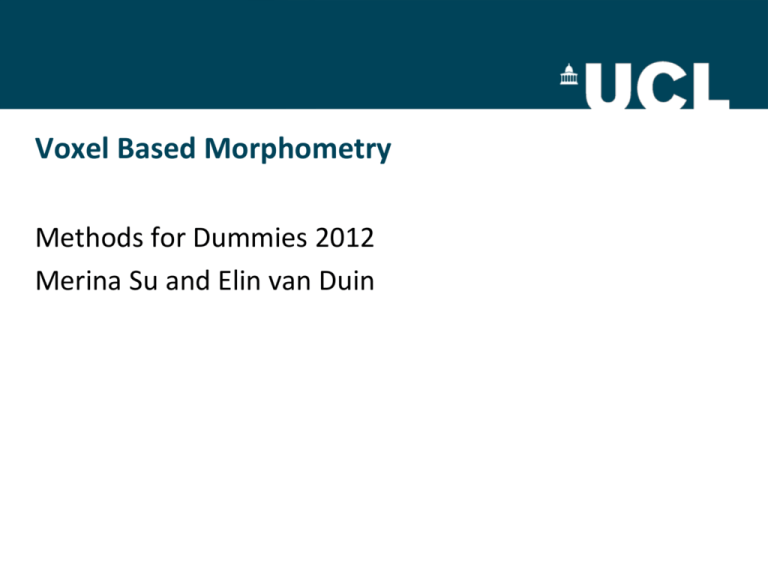
Voxel Based Morphometry Methods for Dummies 2012 Merina Su and Elin van Duin Rebel with a cause “… a linear relationship between grey matter volume (GM) in a region of lateral orbitofrontal cortex (lOFCGM) and the tendency to shift reported desire for objects toward values expressed by other people.” Daniel K. Campbell-Meiklejohn, Ryota Kanai, Bahador Bahrami, Dominik R. Bach, Raymond J. Dolan, Andreas Roepstorff, Chris D. Frith. Structure of orbitofrontal cortex predicts social influence. Current Biology, 2012; 22 (4): R123 DOI: 10.1016/j.cub.2012.01.012 VBM • General Idea • Preprocessing • Analysis VBM overview • Based on comparing regional volumes of tissue among populations of subjects Whole brain instead of comparing volumes of particular structures such as the hippocampus • Produce a map of statistically significant differences among populations of subjects – compare a patient group with a control group – identify correlations with age, test-score etc. Computational neuranatomy Deformation-based morphometry Looks at macroscopic differences in brain shape. Uses the deformation fields needed to warp an individual brain to a standard reference. Tensor-based morphometry Differences in the local shape of brain structures Voxel based morphometry Differences in regional volumes of tissue Procedure overview Spatial normalisation • Transforming all the subject’s data to the same stereotactic space • Corrects for global brain shape differences • Choice of the template image shouldn’t bias final result Segmentation • Images are partitioned into: - Grey matter - White matter - CSF Extra tissue maps can be generated • SPM uses a generative model, which involves: - Mixture of Gaussians - Bias Correction Component - Warping Component Segmentation 2 sources of information: 1. Spatial prior probability maps: • Intensity at each voxel = probability of being GM/WM/CSF • Comparison: original image to priors • Obtained: probability of each voxel in the image being a certain tissue type 2) Intensity information in the image itself • Intensities in the image fall into roughly 3 classes • SPM assigns a voxel to a tissue class based on its intensity relative to the others in the image • Each voxel has a value between 0 and 1, representing the probability of it being in that particular tissue class frequency Segmentation image intensity Smoothing Modulation Non-modulated: Modulated: – Relative concentration/ - Absolute volumes density: the proportion of GM (or WM) relative to other tissue types within a region – Hard to interpret Modulation: multiplying the spatially normalised gray matter (or other tissue class) by its relative volume before and after spatial transformation Preprocessing in SPM: Diffeomorphic Anatomical Registration using Exponentiated Lie algebra (DARTEL) registration • Use New Segment for characterising intensity distributions of tissue classes, and writing out “imported” images that DARTEL can use • Run DARTEL to estimate all the deformations • DARTEL warping to generate smoothed, “modulated”, warped grey matter. Limitations of the current model • Assumes that the brain consists of only the tissues modelled by the TPMs – No spatial knowledge of lesions (stroke, tumours, etc) • Prior probability model is based on relatively young and healthy brains – Less accurate for subjects outside this population • Needs reasonable quality images to work with – No severe artefacts – Good separation of intensities – Reasonable initial alignment with TPMs. Assumptions • You must be measuring the right thing, i.e. your segmentation must correctly identify gray and white matter • Avoid confounding effects: use the same scanner and same MR sequences for all subjects • For using parametric tests the data needs to be normally distributed SPM for group fMRI Group-wise statistics fMRI time-series Preprocessing Spatially Normalised spm T “Contrast” Image Image Preprocessing Spatially Normalised “Contrast” Image Preprocessing Spatially Normalised “Contrast” Image fMRI time-series fMRI time-series SPM for Anatomical MRI Group-wise statistics Anatomical MRI Preprocessing Spatially Normalised spm T Grey MatterImage Image Preprocessing Spatially Normalised Grey Matter Image Preprocessing Spatially Normalised Grey Matter Image Anatomical MRI Anatomical MRI Statistical analysis VBM • • • • • Types of analysis What does SPM show? Multiple corrections problem Things to consider… Interpreting results Types of analysis • Group comparison • Correlation a known score or value • Where in the brain do the Simpsons and the Griffins have differences in brain volume? • Where in the brain are there associations between brain volume and test score? General Linear Model e.g, compare the GM/ WM differences between 2 groups Y = Xβ + ε H0: there is no difference between these groups β: other covariates, not just the mean VBM: group comparison GLM: Y = Xβ + ε • Intensity for each voxel (V) is a function that models the different things that account for differences between scans: • V = β1(Simpsons) + β2(Griffin) + β3(covariates) + β4(global volume) + μ + ε • V = β1(Simpsons) + β2(Griffin) + β3(age) + β4(gender) + β5(global volume) + μ + ε • In practice, the contrast of interest is usually t-test between β1 and β2 “Is there significantly more GM (higher v) in the controls than in the AD scans and does this explains the value in v much better than any other covariate?” Statistical Parametric Mapping… – parameter estimate group 1 standard error group 2 = voxel by voxel modelling statistic image or SPM VBM: correlation • Correlate images and test scores (eg Simpson’s family with IQ) • SPM shows regions of GM or WM where there are significant associations between intensity (volume) and test score V = β1(test score) + β2(age) + β3(gender) + β4(global volume) + μ + ε • Contrast of interest is whether β1 (slope of association between intensity & test score) is significantly different to zero What does SPM show? • Voxel-wise (mass-univariate: independent statistical tests for every single voxel) • Group comparison: – Regions of difference between groups • Correlation: – Region of association with test score Multiple Comparison Problem • Introducing false positives when you deal with more than one statistical comparison – detecting a difference/ an effect when in fact it does not exist Read: Brett, Penny & Kiebel (2003): An Introduction to Random Field Theory http://imaging.mrc-cbu.cam.ac.uk/imaging/PrinciplesRandomFields Multiple Comparisons: an example • One t-test with p < .05 – a 5% chance of (at least) one false positive • 3 t-tests, all at p < .05 – All have 5% chance of a false positive – So actually you have 3*5% chance of a false positive = 15% chance of introducing a false positive p value = probability of the null-hypothesis being true Here’s a happy thought • In VBM, depending on your resolution – 1000000 voxels – 1000000 statistical tests • do the maths at p < .05! – 50000 false positives • So what to do? – Bonferroni Correction – Random Field Theory/ Family-wise error (used in SPM) Bonferroni • Bonferroni-Correction (controls false positives at individual voxel level): – divide desired p value by number of comparisons – .05/1000000 = p < 0.00000005 at every single voxel • Not a brilliant solution (false negatives)! • Added problem of spatial correlation – data from one voxel will tend to be similar to data from nearby voxels Family-wise Error 1 • SPM uses Gaussian Random Field theory (GRF)1 • Using FWE, p<0.05: 5% of ALL our SPMs will contain a false positive voxel • • This effectively controls the number of false positive regions rather than voxels Can be thought of as a Bonferroni-type correction, allowing for multiple nonindependent tests • • Good: a “safe” way to correct Bad: but we are probably missing a lot of true positives http://www.mrc-cbu.cam.ac.uk/Imaging/Common/randomfields.shtml Validity of statistical tests in SPM • Errors (residuals) need to be normally distributed throughout brain for stats to be valid – After smoothing this is usually true BUT – Invalidates experiments that compare one subject with a group • Correction for multiple comparisons – Valid for corrections based on peak heights (voxel-wise) – Not valid for corrections based on cluster extents • This requires smoothness of residuals to be uniformly distributed but it’s not in VBM because of the non-stationary nature of underlying neuroanatomy • Bigger blobs expected in smoother regions, purely by chance Things to consider • Uniformly bigger brains may have uniformly more GM/ WM brain A brain B differences without accounting for TIV (TIV = total intracranial volume) brain A brain B differences after TIV has been “covaried out” (differences caused by bigger size are uniformally distributed with hardly any impact at local level) Global or local change? • Without TIV: greater volume in B relative to A except in the thin area on the right-hand side Brains of similar size with GM differences globally and locally • With TIV: greater volume in A relative to B only in the thin area on the right-hand side Including total GM or WM volume as a covariate adjusts for global atrophy and looks for regionally-specific changes Interpreting results Mis-classify Mis-register Folding Thinning Mis-register Thickening Mis-classify More things to think about • What do results mean? • VBM generally – Limitations of spatial normalisation for aligning small-volume structures (e.g. hippo, caudate) • VBM in degenerative brain diseases: – Spatial normalisation of atrophied scans – Optimal segmentation of atrophied scans – Optimal smoothing width for expected volume loss Extras/alternatives • Multivariate techniques – An alternative to mass-univariate testing (SPMs) – Shape is multivariate – Generate a description of how to separate groups of subjects • Use training data to develop a classifier • Use the classifier to diagnose test data • Longitudinal analysis – Baseline and follow-up image are registered together non-linearly (fluid registration), NOT using spm software – Voxels at follow-up are warped to voxels at baseline – Represented visually as a voxel compression map showing regions of contraction and expansion Fluid Registered Image FTD (semantic dementia) Voxel compression map 1 year contracting expanding In summary • Pro • Con – Fully automated: quick and not susceptible to human error and inconsistencies – Unbiased and objective – Not based on regions of interests; more exploratory – Picks up on differences/ changes at a global and local scale – Has highlighted structural differences and changes between groups of people as well as over time • AD, schizophrenia, taxi drivers, quicker learners etc – Data collection constraints (exactly the same way) – Statistical challenges: – Results may be flawed by preprocessing steps (poor registration, smoothing) or by motion artefacts – Underlying cause of difference unknown – Question about GM density/ interpretation of data- what are these changes when they are not volumetric? Key Papers • Ashburner & Friston (2000). Voxel-based morphometry- the methods. NeuroImage, 11: 805-821 • Mechelli, Price, Friston & Ashburner (2005). Voxel-based morphometry of the human brain: methods and applications. Current Medical Imaging Reviews, 1: 105-113 – Very accessible paper • Ashburner (2009). Computational anatomy with the SPM software. Magnetic Resonance Imaging, 27: 1163 – 1174 – SPM without the maths or jargon References and Reading • Literature • • • • • • • • Ashburner & Friston, 2000 Mechelli, Price, Friston & Ashburner, 2005 Sejem, Gunter, Shiung, Petersen & Jack Jr [2005] Ashburner & Friston, 2005 Seghier, Ramlackhansingh, Crinion, Leff & Price, 2008 Brett et al (2003) or at http://imaging.mrc-cbu.cam.ac.uk/imaging/PrinciplesRandomFields Crinion, Ashburner, Leff, Brett, Price & Friston (2007) Freeborough & Fox (1998): Modeling Brain Deformations in Alzheimer Disease by Fluid Registration of Serial 3D MR Images. • Thomas E. Nichols: http://www.sph.umich.edu/~nichols/FDR/ • • stats papers related to statitiscal power in VLSM studies: Kimberg et al, 2007; Rorden et al, 2007; Rorden et al, 2009 • PPTs/ Slides • • • • • • • Hobbs & Novak, MfD (2008) Ged Ridgway: www.socialbehavior.uzh.ch/symposiaandworkshops/spm2009/VBM_Ridgway.ppt John Ashburner: www.fil.ion.ucl.ac.uk/~john/misc/AINR.ppt Bogdan Draganski: What (and how) can we achieve with Voxel-Based Morphometry; courtesey of Ferath Kherif Thomas Doke and Chi-Hua Chen, MfD 2009: What else can you do with MRI? VBM Will Penny: Random Field Theory; somewhere on the FIL website Jody Culham: fMRI Analysiswith emphasis on the general linear model; http://www.fmri4newbies.com



